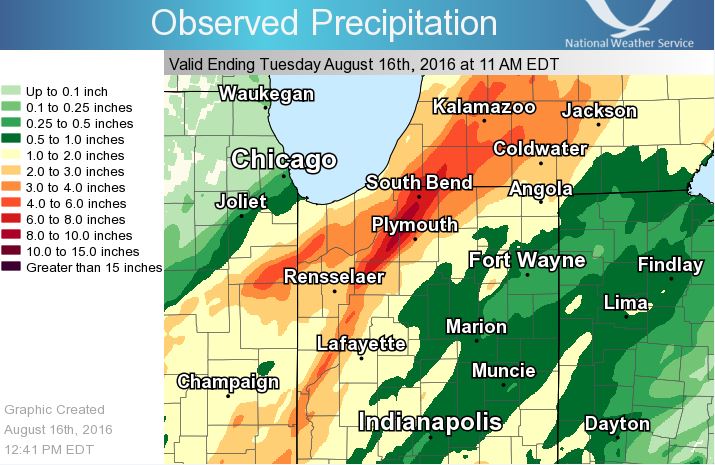Washed Away: How flooding and a disappearing lakeshore have become more severe
Heavy rain and flooding events are occurring more often across not only Michiana, but the Great Lakes region as a whole. That has led to very high to record-breaking lake levels in all five of the Great Lakes.
The two most recent and most significant flooding events that come to mind occurred in August of 2016 and February of 2018.On August 15th, 2016, a tropical air mass worked north out of the Gulf states, providing the ingredients for a widespread heavy rain situation.
The main area of rain impacted a large region, but once that moved away, additional heavy showers developed and impacted the same areas over and over again.
The end result was flash flooding and rapidly rising rivers in nearly every county in the Michiana area.Rainfall totals reached 4" in Elkhart County, 6" in La Porte County, 7" in Berrien County, 7" in Cass County, 10" in St. Joseph County, and 10" in Starke County.
Most of that rain fell in just 12-18 hours at rates of 1-2" per hour, leading to numerous streets going under water, at least a dozen water rescues and multiple flooded residencies.
For perspective, South Bend recorded more rain on August 15th than what typically falls in 2-3 months!Now let's fast forward to February of 2018, when a second thousand-year flood occurred in less than two years!
Many cities across Michiana, including South Bend, Niles, Elkhart, Goshen, and Plymouth, saw roughly a half-foot of rain during the February 19-21 period.
That rain fell on top of a healthy snowpack and frozen ground, creating the perfect recipe for rapidly rising rivers.The St. Joseph River at both Niles and South Bend reached a new all-time record crest level. The Yellow River at Plymouth and the Elkhart River at Goshen also both reached a new all-time height during this event.States of emergency were declared, numerous homes and businesses were under feet of water, roads were closed, and school was canceled in many locations.That was the wettest February in the history of South Bend, and it wasn't even close!
Click here to read all of the stories in our Washed Away series and our Local Climate Impact section
Those are just two of the more memorable and significant flooding events in recent memory. Other heavy rain, high water and flooding episodes have happened since 2000.
One impact of heavier rainfall and more days with rainy weather is the inability for farmers to be as productive as they normally would. For example, 2019 was especially difficult for farmers across the middle of the country.Due to constant days with rain -- and some heavier rain -- states like Illinois, Indiana, Michigan, and Ohio ran below the average throughout 2019 in terms of planting, maintaining and harvesting.
Another resulting issue from all of our heavy rain and flooding episodes over the last several years has been increasing Lake Michigan levels dating back to 2014-2015.
The lake has continued rising, threatening and even breaking multiple records along the way. That includes January of 2020, which could easily break the all-time average lake level for the month based on the latest data.
For more on the beach erosion and high lake levels, click on the links below:
•Year in Review 2019: Beach Erosion











